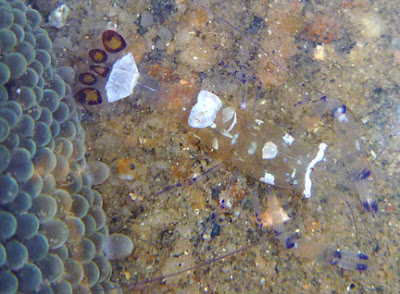What special anemones can we find at Sentosa? We are eager to find out.
There is quite an extensive shore outside the seawalls, and we start there.
Nicholas found many anemones even in the rocky shore near the Resorts World Sentosa worksite. There was a large Giant carpet anemone (Stichodactyla gigantea). Also several Frilly anemones (Phymanthus sp.) and small clump of what looked like Posy anemones.
On the sandy shores behind Underwater World, we saw the Haddon's carpet anemones (Stichodactyla haddoni) that are usually here. Between then a little white blob. More about it below.
There were anemone shrimps (Periclimenes brevicarpalis) in the Haddon's carpet anemone!
The white blob is a Peachia anemone (Peachia sp.) that is commonly seen. Nicholas is looking for brown ones. Alas, all those we saw today were white ones. They have 16 tentacles. The brown ones have more tentacles.
Oh, is this the brown peachia anemone that Nicholas is looking for? We took a closer look, and no, definitely not.
On the high shore, we came across a little shark egg case. There is still a living shark probably inside the case which is obvious if we hold it against the light. We put it into water and hope it will successfully 'hatch'. I don't know why we often come across such egg cases on this part of the shore.
We then headed toward the Tanjung Rimau beacon, passing through lovely natural rocky shores and natural cliffs cloaked in native coastal forest plants. I noticed a lot of sand on the shore.
The Cake sand dollars (Arachnoides placenta) we often encounter here were still there. I saw several today.
Around the corner, a very pebbly rocky shore. Seems a perfect place to find Anthopleura buddemeieri, which so far we've only found on St. John's Island. So we start searching earnestly. Checking under stones, and on rocks.
There were lots of brown blobs in the crevices of rocks. These are probably Anthopleura dixoniana.
While carefully turning over stones, Henry and I found clumps of many African sea cucumbers (Afrocucumis africana) under the rocks!
Henry found a chiton! This intriguing beast is a mollusc! Will it stay small or it is a juvenile of the humungous Acanthopleura gemmata which so far I've only seen on St. John's Island. Another reason to look at this shore more carefully!
It is here that the Critically Endangered Nyireh tree (Xylocarpus rumphii) grows. The mother tree looks lush and happy. But she is not flowering or fruiting today.
We finally found the special anemone under the mother tree! Here, among the big boulders and stones, under the shade of the tree, fed with nutrients from the tree and the coastal forest, it must be a nice place for a hardy anemone. I am already hearing Dr John Yong emphasising how important mangroves are to other coastal habitats!
It has pretty pink spots on the body column.
Here's what it looked like when we put into some seawater. Such a pretty anemone! We're glad to know that it is found elsewhere besides St. John's Island. Hopefully, by searching more carefully, we can find it on more shores! Amazing what we can discover despite our many repeated trips to our shores.
Next to the mother tree is a younger Niyreh tree. It was flowering! I must come back soon to see if it will fruit.
On the way home, we came across a Long-tailed macaque (Macaca fascicularis) foraging for fruits in the coastal forest. We sometimes see these monkeys playing on this natural shore. Our wild monkeys know how to find food in our natural forests and there is enough food for them. So please don't feed the monkeys.
Although the trip was long, it was a pleasant one with the discovery of the pretty pink anemone. It was also good to know that seagrasses are still growing near the RWS worksite.
I thought that was the end of the field trips for this cycle, but tomorrow I'll be out again to help Siti at Chek Jawa. Really looking forward to it!



















